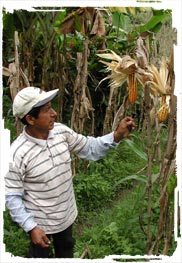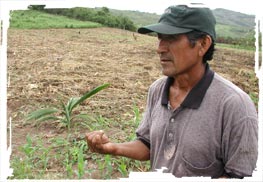May, 2005
 CIMMYT-Peru maize, Marginal 28, outstrips expectations for farmers in Peru
CIMMYT-Peru maize, Marginal 28, outstrips expectations for farmers in Peru
On a hillside that abuts more than 3,000 kilometers of Amazonian expanse beginning in Peru and reaching clear across Brazil to the Atlantic, farmer Virgilio Medina Bautista weeds his maize field under the stifling equatorial sun. He and his wife Sabina Bardales typically arise before dawn to cook a meal for their field workers, and will work all day until bedtime, around 9 p.m. “We come to the field with the food for brunch and ready to work,” Medina says. “It’s a hard life, but there’s no other way, for someone without an education.”
Like 90% of the farmers in this region of Peru—the lowland zones east of the Andes known as the “jungle”—as well as many on the coastal plains or in inter-Andean valleys, Medina sows Marginal 28. This open-pollinated maize variety, developed in the 1980s by Peru and CIMMYT, is popular for its high yields and broad adaptation. It provides two or three times the average yield of the local variety it replaced, and grows well in diverse environments. “Private companies have been trying to introduce maize hybrids here, but they yield only six tons per hectare,” says Edison Hidalgo, maize researcher from the National Institute of Agricultural Research (INIA) “El Porvenir” experiment station, whose staff help spread productive farming practices throughout the region. “Marginal 28 gives that or more, under similar management, and because it’s an open-pollinated variety, farmers don’t have to purchase new seed every season.”
Luis Narro, CIMMYT maize researcher in South America and a native of Peru who helped develop Marginal 28, says the cultivar’s adaptation and uses have far outstripped expectations. “This variety is sown most widely in jungle zones—truly marginal, lowland areas characterized by poor soils, heavy weeds, and frequent drought, to name a few constraints,” Narro says. “But I was just at a station in Ayacucho, at over 2,700 meters in the Andes, and saw seed production fields of Marginal 28 where the yields were probably going to hit seven tons per hectare.” Farmers in jungle areas use it chiefly in animal feeds or for export to the coast. Coastal farmers grow Marginal 28 because the seed is relatively cheap and yields high-quality forage for their dairy cattle. In the Andes, the grain goes for food and snacks.
Its adaptability may be explained in part by its genetically diverse pedigree, which even includes as a parent an internationally recognized variety from Thailand. “This suggests part of the value of a global organization like CIMMYT, which can combine contributions from around the world to develop a useful product for small-scale farmers,” Narro says.
Can Poor Farmers Stop Chopping Down Jungles?
 Despite the clear benefits of Marginal 28, Peruvian farmers are still struggling as markets shift, production costs rise, and maize prices remain low. Farmer Jorge Dávila Dávila, of Fundo San Carlos, in Picota Province, in the Amazon region of Peru, grows maize, cotton, banana, and beans on his 10-hectare homestead. Because he is relatively far from the trans-Andean highways leading to the coast, where maize is in heavy demand for use in poultry feed, middlemen pay him only US $70 per ton of maize grain—well below world market prices. “Maize is a losing proposition; that’s why so many farmers here are in debt,” he says. “They can’t take their maize to local companies for a better price, because they already owe it to the middlemen who provide inputs.”
Despite the clear benefits of Marginal 28, Peruvian farmers are still struggling as markets shift, production costs rise, and maize prices remain low. Farmer Jorge Dávila Dávila, of Fundo San Carlos, in Picota Province, in the Amazon region of Peru, grows maize, cotton, banana, and beans on his 10-hectare homestead. Because he is relatively far from the trans-Andean highways leading to the coast, where maize is in heavy demand for use in poultry feed, middlemen pay him only US $70 per ton of maize grain—well below world market prices. “Maize is a losing proposition; that’s why so many farmers here are in debt,” he says. “They can’t take their maize to local companies for a better price, because they already owe it to the middlemen who provide inputs.”
Unlike most peers, Dávila makes ends meet through hard work and what he calls “an orderly approach” to farming. Many in the region slash and burn new brushland, cropping it for two or three seasons till fertility falls off, and then they move to new land. Dávila has stayed put for eight years on the same fields. “I tell my neighbors not to cut down their jungle,” he says. “I’ve seen that leaving it brings me rain.” With support from INIA researchers like Hidalgo, Dávila is testing conservation agriculture practices. For example, on one plot he plans to keep maize residues on the soil surface and seed the next crop directly into the soil without plowing. Research by CIMMYT and others has shown that this practice can cut production costs, trap and conserve moisture, and improve soil quality.
For further information, contact Luis Narro (l.narro@cgiar.org)